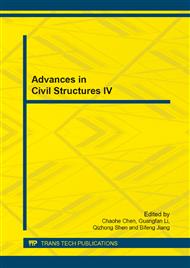p.1498
p.1504
p.1512
p.1522
p.1531
p.1538
p.1542
p.1551
p.1556
Modelling Pore Structure of Cement Based Material According to Continuous Network System
Abstract:
In this study, a modified pore structure of cement based material with respect to a path for ingressive ions was established. Of pores in a concrete, gel pores and other entrapped air voids were excluded from modelling the pore structure as no interests are given due to the ions immobilization of cement paste media. To setup the pore structure, the linear traverse method (LTM) was used to distribute air voids along the traverse line in a hexahedron cement paste structure, followed by including entrained air voids to fill up the least space of the cement matrix and making a network of the air voids through capillary pores at the variation in the diameters. Then the mercury intrusion porosimetry (MIP) was used to iteratively approach an accordance rate with calculated one from the above way to get into appropriate convergence value. As a result, for the OPC specimen the developed model shows a somewhat relevant value of 42.4 % of the accordance rate compared to empirical one and 64.24 of the ratio of ionic path to original distance within a concrete.
Info:
Periodical:
Pages:
1531-1537
Citation:
Online since:
July 2014
Authors:
Keywords:
Price:
Сopyright:
© 2014 Trans Tech Publications Ltd. All Rights Reserved
Share:
Citation:


